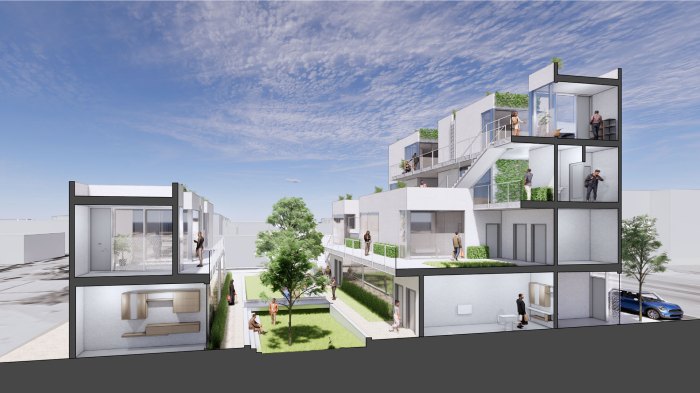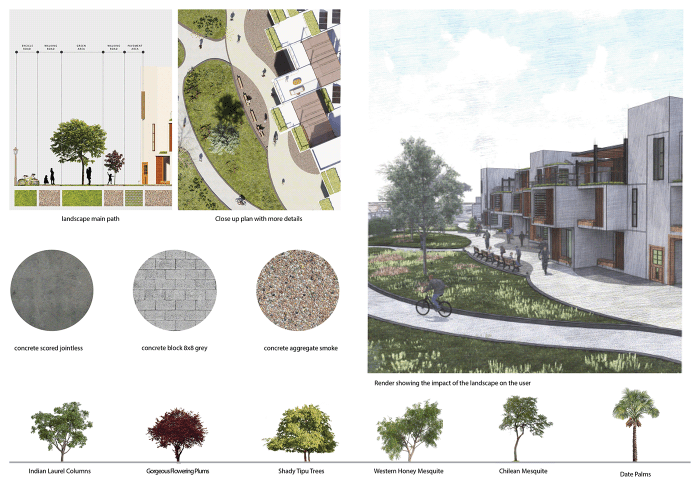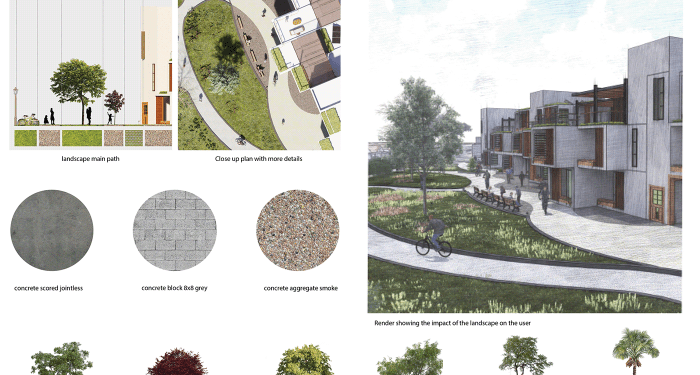Delving into the realm of Affordable housing architecture design concepts reveals a world where creativity and practicality converge to shape the homes of the future. From space optimization to community-centric designs, this topic showcases the ingenuity and foresight architects bring to affordable housing projects.
Affordable Housing Architecture Design Concepts
Affordable housing architecture focuses on designing cost-effective residential buildings that provide safe and comfortable living spaces for low to moderate-income individuals and families. The key principles of affordable housing architecture include efficient space utilization, use of sustainable materials, energy efficiency, and community integration.
Innovative Design Concepts in Affordable Housing Projects
Innovative design concepts play a crucial role in creating affordable housing that is both functional and aesthetically pleasing. Some examples of innovative design concepts used in affordable housing projects include:
- Modular Construction: Prefabricated modules that can be easily assembled on-site to reduce construction time and costs.
- Adaptive Reuse: Repurposing existing buildings or structures to create affordable housing units, preserving historic elements while reducing construction expenses.
- Shared Spaces: Incorporating communal areas such as gardens, playgrounds, or community centers to foster a sense of belonging and social interaction among residents.
- Green Roofs: Installing vegetation on rooftops to improve insulation, reduce energy consumption, and enhance the overall aesthetics of the building.
Importance of Sustainability in Affordable Housing Architecture
Sustainability is a critical aspect of affordable housing architecture as it ensures the long-term viability of the building while minimizing environmental impact. By incorporating sustainable design practices such as energy-efficient systems, water conservation measures, and use of recycled materials, affordable housing projects can reduce operational costs, improve indoor air quality, and contribute to a healthier living environment for residents.
Additionally, sustainable design enhances the overall resilience of affordable housing buildings, making them more adaptable to changing environmental conditions and reducing maintenance expenses in the long run.
Space Optimization
Space optimization is a crucial aspect of affordable housing architecture design, as it allows architects to maximize the functionality and livability of limited spaces while keeping costs low. By employing various techniques and flexible design solutions, architects can create efficient layouts that make the most out of every square foot.
Comparing Space-Saving Techniques
- Compact Layouts: Utilizing compact layouts that eliminate wasted space and focus on essential living areas.
- Multifunctional Furniture: Incorporating multifunctional furniture pieces that serve dual purposes to save space.
- Vertical Storage: Implementing vertical storage solutions to maximize space utilization without sacrificing storage capacity.
- Open Floor Plans: Designing open floor plans that create a sense of spaciousness and flexibility within a small footprint.
Role of Flexible Design Solutions
Flexible design solutions play a key role in maximizing space efficiency in affordable housing projects. By incorporating elements such as movable walls, sliding doors, and modular furniture, architects can adapt the layout of a space to meet the changing needs of its residents.
This adaptability ensures that every square inch is utilized effectively, enhancing the overall functionality and comfort of the living environment.
Material Selection
When it comes to affordable housing architecture design, material selection plays a crucial role in determining the overall cost, sustainability, and aesthetics of the project. Architects often opt for sustainable and cost-effective materials to ensure that the housing units are not only affordable but also environmentally friendly.
Sustainable and Cost-Effective Materials
- Bamboo: Bamboo is a sustainable material that grows quickly and is incredibly strong. It is often used for flooring, walls, and even structural components in affordable housing projects.
- Recycled Steel: Using recycled steel in construction helps reduce the environmental impact of the project while also being cost-effective. It is commonly used for framing and structural support.
- Rammed Earth: Rammed earth is a durable and sustainable material made by compacting earth, sand, and gravel into solid walls. It is an affordable option that provides excellent thermal insulation.
Impact of Material Selection
The choice of materials significantly affects the design and affordability of housing projects. Sustainable materials not only reduce the environmental footprint of the construction but also lower maintenance costs in the long run
Creative Use of Recycled Materials
- Plastic Bottle Walls: Architects have found creative ways to incorporate recycled plastic bottles into affordable housing projects by using them as building blocks for walls. This not only reduces waste but also provides insulation.
- Tire Roofs: Old tires can be repurposed into roofing materials for affordable housing units. They are durable, inexpensive, and help reduce the carbon footprint of the construction.
- Pallet Furniture: Recycled wooden pallets can be transformed into functional furniture pieces for affordable housing units, adding a touch of sustainability and creativity to the interior design.
Community-Centric Design

Community spaces play a crucial role in affordable housing developments as they foster a sense of belonging, encourage social interactions, and promote a supportive environment for residents.
Incorporating Community Spaces
Creating communal areas within affordable housing projects is significant as they provide residents with spaces to socialize, engage in activities, and build relationships with their neighbors. Architects often incorporate community spaces such as common rooms, shared gardens, playgrounds, and multipurpose halls to promote a sense of community within the development.
- Common Rooms: These areas serve as gathering spaces for residents to come together for events, meetings, or simply to interact with one another.
- Shared Gardens: Green spaces within the housing complex offer residents a place to relax, connect with nature, and engage in community gardening activities.
- Playgrounds: These areas are essential for families with children, providing a safe and fun environment for kids to play and socialize with their peers.
- Multipurpose Halls: These versatile spaces can be used for various community events, workshops, celebrations, and gatherings, enhancing social interactions among residents.
Design Strategies for Community Engagement
Architects employ various design strategies to promote a sense of community and social interaction among residents living in affordable housing projects. These strategies include:
- Central Courtyards: Designing a central courtyard as a focal point where residents can come together, interact, and engage in communal activities.
- Shared Amenities: Providing shared amenities such as fitness centers, libraries, or co-working spaces that encourage residents to connect and collaborate.
- Walkable Layouts: Creating pedestrian-friendly layouts with walkways, seating areas, and gathering spots to facilitate chance encounters and social interactions among residents.
- Community Events: Organizing regular community events, workshops, or classes within the housing complex to promote social engagement and a sense of belonging.
Wrap-Up

In conclusion, Affordable housing architecture design concepts offer a glimpse into a future where sustainability, innovation, and community integration are at the forefront of housing development. By exploring the key principles and examples discussed, it becomes evident that the future of affordable housing holds immense potential for creating thriving and inclusive communities.
Expert Answers
How do architects optimize space in affordable housing projects?
Architects optimize space in affordable housing projects by utilizing clever layout designs, multifunctional furniture, and maximizing natural light.
What are some sustainable and cost-effective materials commonly used in affordable housing construction?
Common materials include bamboo, recycled wood, straw bales, and reclaimed materials like metal and glass.
Why is community-centric design important in affordable housing developments?
Community-centric design fosters a sense of belonging, encourages social interaction, and promotes a supportive environment among residents.



